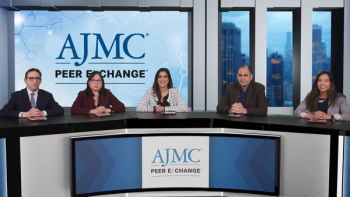
Challenges in Diagnosing, Treating IPF and PPF: Toby Maher, MD, PhD

Key Takeaways
- Early diagnosis and treatment in IPF and PPF are vital, as fibrosis is irreversible and current therapies only slow progression.
- Current IPF treatments, pirfenidone and nintedanib, have significant side effects, limiting their use and leading to treatment discontinuation.
Early diagnosis and treatment are crucial for managing idiopathic pulmonary fibrosis and progressive pulmonary fibrosis, yet barriers hinder timely intervention.
In idiopathic pulmonary fibrosis (IPF) and progressive pulmonary fibrosis (PPF), early diagnosis is key to initiating therapy and slowing progression for patients with these incurable conditions.
Toby Maher, MD, PhD, professor of clinical medicine and director of Interstitial Lung Disease at the Keck School of Medicine at the University of Southern California, discussed the current standard of care in IPF and PPF and areas of unmet need in an interview with The American Journal of Managed Care® (AJMC®).
This transcript has been lightly edited.
AJMC: What is the current standard of care in IPF, and where do the most significant clinical gaps and areas of high unmet need remain? What about PPF?
Maher: Until a month ago, the standard of care for IPF was treatment with either pirfenidone or nintedanib. Since the beginning of October, we've had a third option, nerandomilast, but we're only just sort of beginning to understand how we might use that in practice. I think with pirfenidone and nintedanib, they've been important for the care of patients, and I think they have made a difference. But the reality is, patients are still, unfortunately, dying from respiratory failure and from IPF, so they haven't completely changed the treatment landscape. At the same time, both pirfenidone and nintedanib have significant side effects, mainly gastrointestinal, and that has limited their use because many community pulmonologists have been hesitant to start patients on treatment with side effects. And many patients who have started treatment have discontinued it because of the side effects, so a lot of patients with IPF haven't really been on any long-term consistent therapy, despite the availability of the treatments.
PPF is slightly different because it covers a broader range of conditions, and for some of those conditions, particularly the autoimmune diseases like scleroderma and rheumatoid arthritis, we have some treatments for the underlying condition itself. For other conditions like hypersensitivity pneumonitis, we know that there's a role for patients avoiding exposure to things that might have triggered it in the first place, and there's also probably a role for steroids and immunosuppression. But when all of that has failed and patients have developed worsening fibrosis, then we've had nintedanib available as a treatment for that group of patients. The limitations are the same that we have seen for IPF, so the challenge is that patients do continue to progress on treatment—albeit more slowly—and many patients have struggled to tolerate the side effects.
AJMC: From a clinical perspective, what are the critical steps and criteria for recognizing PPF, and what challenges inhibit early diagnosis?
Maher: The concept of PPF is really what the name describes, which is that it's patients who have progressive fibrosis that is caused by a condition other than idiopathic pulmonary fibrosis. I think people get a little bit caught up in the guidelines and the specifics of the criteria that are needed to meet a diagnosis, but the reality is that what we've tried to do is just formalize the identification of patients whose fibrotic lung disease is getting worse over time. There are 2 sets of criteria that people typically use: the criteria that were originally used in the INBUILD trial for nintedanib that have then tended to be used in other clinical trials or, more recently, the American Thoracic Society–European Respiratory Society guideline criteria.
Ultimately, they're very similar. There are some subtle differences, but both sets use a combination of either lung function decline, FVC [forced vital capacity] or DLCO [diffusing capacity of the lungs for carbon monoxide]; symptom decline, so worsening breathlessness; or radiological worsening, appearances of worsening fibrosis on CT, to define progression. The thresholds are slightly different for the 2 sets of criteria. I think the real challenge that inhibits an early diagnosis is that we're waiting for progression. We know from IPF that progression is a bad thing, because once fibrosis has developed, it's irreversible. We can't get rid of it with treatment. I think one of the downsides of the current criteria for progressive pulmonary fibrosis is that we're waiting for patients to get irreversibly worse before we can start treatment. I think that's the major weakness with the criteria as it stands.
To what extent are early diagnosis and intervention critical in IPF and PPF, and what barriers exist to initiating antifibrotic therapy promptly?
Maher: It’s similar and different for the 2 conditions. As I've alluded to, once fibrosis develops, it’s irreversible. Therefore, I think early identification and early treatment are critically important, particularly as the treatments we have available sort of slow decline. They don't prevent it, and they certainly don't reverse it. Particularly for IPF, I think early diagnosis and early initiation of treatment are really important, because the earlier we can intervene, the longer we can preserve patients’ lung function. I think the main barriers to early diagnosis and treatment in IPF are, first, a difficulty for nonspecialists to identify the disease correctly on CT. I think things have improved over the last decade with education, but there is probably still room for improvement to aid early diagnosis of patients with IPF. For PPF, again, it's similar, but as we've just alluded to, by definition, we're waiting for deterioration to happen before we start treatment. But I think it's critically important that these patients are monitored frequently so that decline, when it happens, is picked up at the earliest possible point.
AJMC: How does treatment discontinuation, dose reduction, or nonadherence among patients receiving standard therapies for IPF or PPF impact outcomes?
Ultimately, as we've said, the treatments that we have available are there to slow or ideally prevent worsening of fibrosis. If patients can't remain on treatment or tolerate treatment, they're obviously not going to get the benefit of treatment. I think the issues that we've seen with drug tolerability have had an impact for many patients on their ability to actually benefit from treatment. The hope is with newer, better, more tolerable therapies, that won't be such an issue going forward.
Newsletter
Stay ahead of policy, cost, and value—subscribe to AJMC for expert insights at the intersection of clinical care and health economics.













































